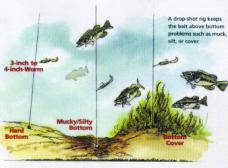Dropshot fishing for summer bass
Bass can be notoriously difficult to catch during the ‘Dog-Days’ of summer. Most anglers understand that as soon as fishing becomes tough, it is time to pick up the finesse baits.
One finesse technique that is often overlooked by bass anglers is the Dropshot Rig, either because they don’t know how to apply the technique, are intimidated by it, or have not had much success previously using the rig.
One very important factor to keep in mind when attempting to dropshot for bass - the importance of understanding your electronics and being able to ‘see’ underwater. This is key! Dropshot fishing and a fishfinder go hand-in-hand, period!
Before you attempt to dropshot, make sure you know how to ‘read’ the screen on your fishfinder. Do you know how to identify a hard bottom from a soft bottom? Can you tell the difference between a rock pile and a brush pile? And most importantly, do you know how to ‘spot’ a fish suspended close to or amongst the cover and
structure? If your answer to all of these questions is yes, then you are ready to experience the awesomeness of dropshot fishing.
A dropshot rig for bass fishing is recognised by the unique way the lure is presented to the bass; the weight is attached to the end of the line, a light wire hook directly tied onto the line (Palomar- or Double-Clinch Knot) 15- to 30cm above the weight, and a light finesse worm nose-hooked, whacky-rigged or Texas-rigged.
The rig is traditionally fished vertically in deep water, and used to target suspended fish. The direct attachment of the hook to the line imparts ‘action’ to the bait, even with the subtlest of twitches to the rod tip, which makes it ideal for fishing in one spot. However, there are no rules to presentation. This rig can be fished fast or slow, deep or shallow, vertical or horizontal, or any other way you may choose.
If a fish bites, think about why it bit – depth, speed, structure, etc, and then try to duplicate.
Terminal tackle should include the following: Aggressive fish / Heavier cover / tournament fishing = 6 ½- to 7-foot medium action baitcasting rod, 10- to 16-pound fluorocarbon line, and ¼- to ½-ounce dropshot weights. Inactive fish / Tough fishing / light cover – 6 ½- to 7-foot medium light spinning rod, 6- to 8-pound fluorocarbon line, and 1/8- to ¼-ounce dropshot weights.
Soft tackle may consist of any style of light or finesse-type plastic bait. Straight-tailed worms – 4” YUM Mighty Worm or Dinger, specially designed shaking baits – YUM Shakalicious, fluke-style baits - YUM Money Minnow, craw-style baits – YUM Big Show Craw, etc. can all be used in a dropshot presentation.
Hook any of these baits through the nose or halfway through the body (whacky-style) for optimal movement and action. By rigging the worm Texas-style, you will be able to fish the rig weedless through cover (brush, grass or other aquatic weed).
Make sure to align the bait straight onto the hook, to avoid line twist during the retrieve. Line twist is caused when the worm ‘spins’ during the retrieve. You do not want this. Once you have rigged the worm, reel in and watch as it comes through the water. If it swims straight, without twisting, you are ready to start fishing.















0 Comments